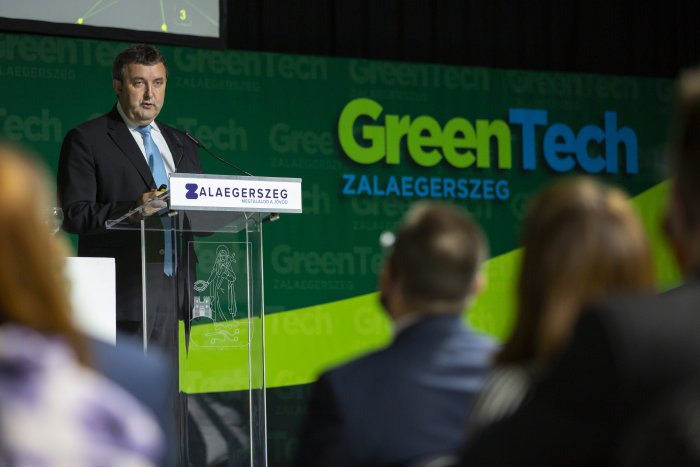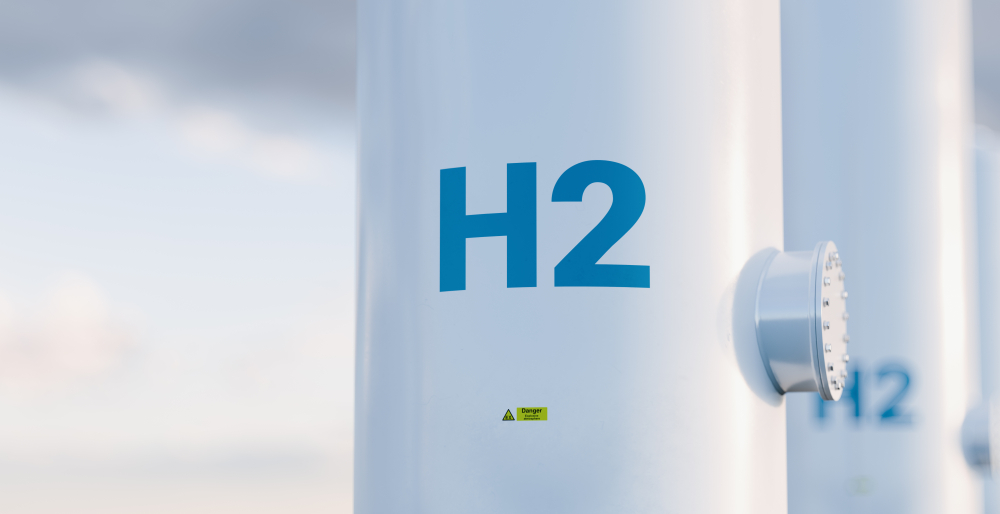Nuclear Still Dominant as Renewables Gain Further Ground in Hungaryʼs Energy Mix

György Varga / MTI
While renewable energy sources produce an increasing ratio of Hungary’s energy mix, and the country is set to go significantly greener in the upcoming years, nuclear energy is still the single major power source, and will remain so for the coming decades.
Minister for Innovation and Technology László Palkovics speaking at the opening of the GreenTech - Green Energy and Sustainability exhibition and conference at the Dezső Keresztury City Cultural Center in Zalaegerszeg on September 25, 2020. Photo by György Varga / MTI
In 2019, Hungary’s energy mix consisted of 49% nuclear, 23% gas, 15% coal and 12% renewables, the latter growing in accordance with EU directives relating to green electricity.
An International Atomic Energy Agency (IAEA) report last year tagged the mix as “well-balanced” and noted that green energy production is expected to rise “steeply” in the next few years as various forms of renewable energy sources receive generous support.
Hungary’s energy production is heavily reliant on the country’s nuclear power plant at Paks with four blocks with a nominal capacity of 500MW. Currently, the Paks II expansion project is adding two further blocks.
Minister Without Portfolio János Süli, who is in charge of the nuclear plant upgrade, said at the end of June that Hungary had applied for an implementation license for the two new blocks at the plant to the National Atomic Energy Office (OAH).
The minister said the license, the application for which will be reviewed by the OAH in 12 months, certifies that the additions meet all relevant safety requirements.
With the expansion of Hungary’s nuclear power generation capacity, and by further increasing renewable energy sources in the national mix, energy policy-wise the country should see more stability, says Károly Kovács, project leader of the GreenTech Zalaegerszeg Green Energy and Sustainability Conference.
In the upcoming decade, if nuclear and renewable energy production together can increase above 75%, Hungary may be in a position to export its surplus, which would increase its energy sovereignty, he says.
In the foreseeable future, Hungary’s energy mix, as well as that of the 26 other EU member states, will move away from non-renewables towards greener sources.
European Union decision-makers are currently working on the EU’s “New Green Energy Deal”, aiming to reach climate neutrality, better known as carbon neutrality, which means having a net-zero carbon footprint, by 2050.
Highly Challenging
It will be highly challenging though, as many factors are at play. Becoming carbon-neutral would mean that all coal activity, as an energy source, needs to come to an everlasting halt. However, departure from this source is not as simple to execute as it is to say.
Regions where coal mining is prominent are economically heavily reliant on activities relating to coal, both directly and indirectly. In Hungary, where coal mining supports 15% of the energy mix, total conventional energy resources comprised about 10.5 billion tonnes of coal, 4.1 trillion cubic meters of fossil gas and 0.8 billion cubic meters of oil, according to data from the European Association for Coal and Lignite (EURACOAL) in 2018.
If coal mines are to be closed down, that can only be done with proper planning and a just transition to ensure that families and regions who depend on the activity are well prepared.
“We will need to work together across different levels of government and across party lines to provide enough opportunities, secure jobs and bring investments where they are needed most,” Frans Timmermans, one of three senior commissioners in the European Commission responsible for the European Green Deal and the EU’s climate policy, said during a discussion panel at the Katowice European Economic Congress via an online conference.
Poland, most of whose power comes from coal and which is Europe’s second largest coal producer after Germany, is the only country not to have signed up to the EU’s 2050 carbon neutral aims, yet, though international news wire Reuters has reported in the past few days that Poland’s government struck a deal with trade unions on September 25 to gradually close its coal mines by 2049.
Although the EU’s Green Deal has no concrete roadmap yet, countries in the bloc are increasingly showing greater commitment towards a greener future. In Hungary, Parliament approved a bill on climate protection in June to reduce greenhouse gas emissions and increase the ratio of renewable energy sources.
By 2030, Hungary aims to reduce greenhouse gas emissions by at least 40%, compared to the levels measured in 1990. The ratio of renewables is set to creep above 21% by 2030. The act says Hungary will reach full climate neutrality by 2050, in line with the EU’s vision.
Solar Panel Subsidies
The Hungarian government is planning to launch subsidies that will cover 30-40% of solar panel installation costs on detached homes, Minister for Innovation and Technology László Palkovics said at the GreenTech exhibition and conference in Zalaegerszeg on September 25.
The subsidies will be financed from the national central budged and EU funding. The minister added that the government is planning to support the use of renewable energy with credit and grants.
In his speech at the Zalaegerszeg expo, Palkovics identified four conditions as prerequisites for carbon neutrality. First, those countries and businesses whose activities excessively pollute the environment will need to add more to the financing of the transition to climate neutrality.
Second, the transition must happen without causing spikes to energy and food prices. Third, Palkovics finds it “unacceptable” that the poorer and developing countries lose out on cohesion funds that would support the transition.
Fourth, the minister stressed that there is no climate-neutral economy without nuclear energy, therefore, he believes nuclear energy use should not to be banned, as many Green politicians demand, but supported on the European continent.
As renewable sources deliver an increasingly larger slice of the energy mix for Hungary, anticipation hints at a busy market in the near future. The National Bank of Hungary (MNB) in mid-September published a collection of proposals and initiatives to promote environmentally sustainable economic growth, based on a consultation with NGOs, environmental scientists, climate protection and energy experts.
The MNB proposed “green taxation” for vehicles and transportation to improve air quality, lowering taxes for energy efficiency investments, extending the carbon taxing system and raising environmental charges and fees, among many other ideas.
As solar panels are springing up in fields across Europe and silent electric vehicles roam our roads in increasing numbers, it is safe to assume that today, economies and individuals are well beyond the brink of transition towards a greener, and hopefully healthier, energy mix.
SUPPORT THE BUDAPEST BUSINESS JOURNAL
Producing journalism that is worthy of the name is a costly business. For 27 years, the publishers, editors and reporters of the Budapest Business Journal have striven to bring you business news that works, information that you can trust, that is factual, accurate and presented without fear or favor.
Newspaper organizations across the globe have struggled to find a business model that allows them to continue to excel, without compromising their ability to perform. Most recently, some have experimented with the idea of involving their most important stakeholders, their readers.
We would like to offer that same opportunity to our readers. We would like to invite you to help us deliver the quality business journalism you require. Hit our Support the BBJ button and you can choose the how much and how often you send us your contributions.









